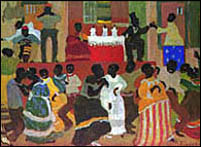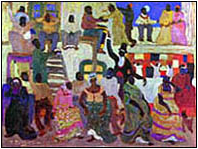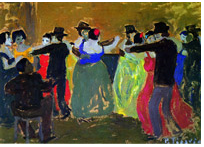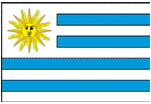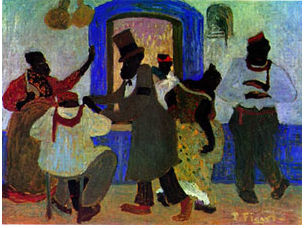What is Candombe?
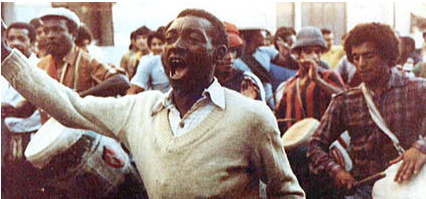 | Candombe (can-dome-bey) is an African derived rhythm that has been an important part of Uruguayan culture for over two hundred years. Uruguay, with a population of approximately 3.2 million, is a small country located in South America, bordered by its two massive neighbors, Brazil (162 million) to the East, and Argentina (34 million) to the West. This rhythm traveled to Uruguay from Africa with black slaves, and is still going strong in the streets, halls and carnivals of this small enchanting country. |
| To understand how this rhythm, which is so strongly rooted in Uruguayan culture evolved, one would need to turn back the pages of African and South American history to look at how this contagious rhythm anchored at the shores of Montevideo. The text that follows are excerpts from books and articles written about candombe, as well as the viewpoint of individuals who have been close to this scene. Montevideo, the capital of Uruguay, was founded by the Spanish in a process that was begun in 1724 and completed in 1730. African slaves were first introduced to the city in 1750. The roots of this population were not homogeneous, but rather a multi-ethnic swath of Africa that was culturally quite varied. 71% were sourced from the Bantu area, from Eastern and Equatorial Africa, while the rest came from non-Bantu Western Africa: Guinea, Senegal, Gambia, Sierra Leone, and the Gold Coast (what is today Ghana). | 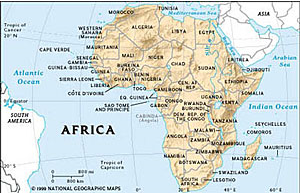 |
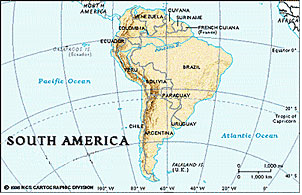 | The Bantu area is an enormous cultural region of Africa with an extremely complex mosaic of ethnicities, consisting of over 450 groups with a linguistic heritage that overwhelms man's migratory limits: more than 20 linguistic groups and 70 dialects. * these indices were compiled from documents of the Montevideo census of 1812, part of the nation's general archives. |
It is believed that no less than ten million "ebony pieces" disembarked on the coasts of North and South America. This implies a bleeding of sixty million souls, if we consider that only one of every six victims of this human traffic ever made it alive to the harbors where they were to be auctioned. To understand what this meant, in demographic terms, it is sufficient to consider that at the beginning of the 19th Century, Buenos Aires had a population of merely 50 thousand. Biafra was dead, nobody wanted to get there * from the candombe "Biafra" by Ruben Rada, in the introduction to the book "Los Tambores del Candombe" by Luis Ferreira | 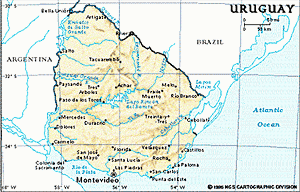 |
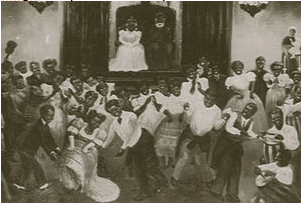 | Candombe is what survives of the ancestral heritage of Bantu roots, brought by the blacks arriving at the Río de la Plata. The term is generic for all black dances: synonymous with and evoking the rituals of that race. Its musical spirit sums up the sorrows of the unfortunate slaves, who were hastily transplanted to South America to be sold and subjected to brutal work. These were pained souls, harboring an inconsolable nostalgia for their homeland. During colonial times, the newly arrived Africans called their drums tangó, and used this term to refer to the place where they gathered to perform their candombe dances; by extension, the dances themselves were also called tangós. With the word tangó, they defined the place, the instrument, and the dance of the blacks. At the dawn of the 19th Century, Montevideo's Establishment was deeply troubled by the existence of the candombes, which they indistinctly called tambo or tangó. They banned them and harshly punished their participants, considering the dances a threat to public morals. In 1808 the citizens of Montevideo requested that the governor repress these dances even more severely and "prohibit the tangós of the blacks." |
In Africa, Tambor and the person playing it are defined by the same word, Tambor. The African poet Amos Totuola writes: "Kalunga kalungangue O-je o-je Imbambue." | 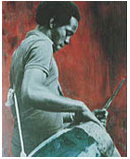 |
 | Candombe (24cm x 64cm) painting by Pedro Figari. Painted in the year 1932 ( he was 71 years of age at that time), one should consider that the image above was painted from Figari's memories of his childhood, which reflects the mid-nineteenth century candombe-gatherings, as described. |
The houses where the slaves gathered, with their masters' permission, were off-limits to the general public in Montevideo of old. These were called tangós, and within their walls the slaves celebrated their festivities and ceremonies to the sound of the Tambor. From this period of original celebrations in Uruguay, only the musical gathering is retained today, and find their principal manifestation in the "llamadas" of Barrio Sur and Palermo. In the sounds of the piano, the chico and the repique, the slaves have been able to preserve their ancestral memory. |
|
| The tango developed simultaneously in Montevideo and Buenos Aires. Although typically regarded as the creation of Italian and Spanish immigrants, the tango's music and the dance movements associated with it were deeply influenced by African dance and music, according to experts. El Tango by Pedro Figari 35x50cm |
In Uruguay, people of African descent accounted for about half the population two centuries ago; they now number about 189,000 in a nation of 3.2 million. After independence was declared in 1825, civil wars disrupted the republic for almost 75 years. Military rule muzzled Uruguay from 1973 until democracy was restored in 1985, when many refugees came home. About 90 percent of Uruguayans - most of Spanish or Italian descent - live in cities, with Montevideo home to two-fifths. Education is compulsory and free, one of Latin America's most literate. |
Oriental Republic of Uruguay |
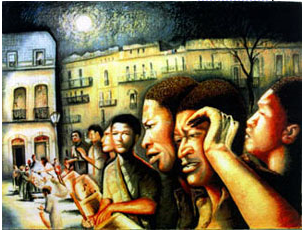 | Montevideo, Uruguay-On Sunday nights, the drummers of Barrio Sur assemble by firelight at an intersection in the historic black neighborhood in a tranquil corner of South America. Flames dance in a gutter bonfire lighted to tone the hides of the drums. Rows of drummers pound down the street in a blur of muscle, sweat and sound, filling the night with an African-derived rhythm known as candombe. Luna, Barrio y Tamboril by Fernando Gomez Germano The street-corner ritual is part of a neglected chapter of the African diaspora. The drums tell a story of the profound impact that African culture has had in Uruguay and elsewhere in Latin America. In fact, Afro-Uruguayans celebrate an often-ignored piece of history |
The Creole, who once formed the whole nation, now prefers to be one of many. So that there may be greater glories in the land, glories must be forgotten. The memory of them is almost an act of remorse, the reproach of things abandoned without the intercession of a goodbye. It is a memory which is rescued, as the Creole destiny requires, for the gallantry and perfection of its sacrifice. Nostalgias del Candombe by Pedro Figari 60x80cm |
|
The candombe rhythm is created by the use of three drums (tambores), tambor piano, tambor chico and tambor repique. When these three drums heat up, it's like nothing you've ever heard before….three tambores.

